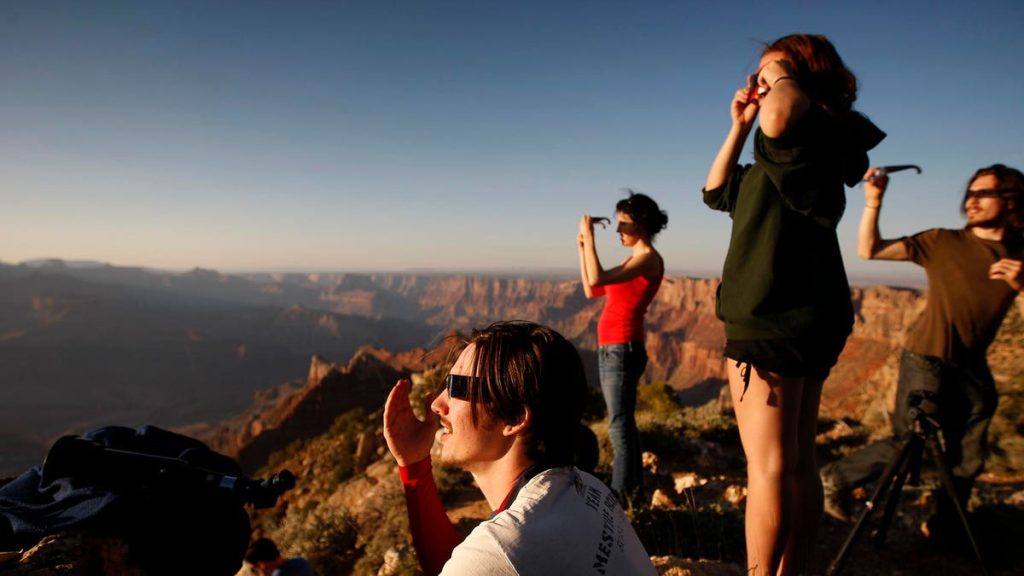The imminent government shutdown could cause the closure of U.S. National Parks preparing for a major solar eclipse on Saturday, October 14.
That would disrupt travel plans for thousands of people headed to dozens of parks in the western U.S. warn experts.
“The trouble for the shutdown this year is it’s happening October 1, just two weeks before an annular solar eclipse is crossing through over a dozen iconic and heavily visited national parks in the American southwest, said astronomer, artist and eclipse-chaser Tyler Nordgren, talking at the Solar Eclipse Planning Workshop this weekend in San Antonio, Texas.
Over 100 events organizers gathered in the city’s Scobee Education Center at San Antonio College to discuss plans for both the annular solar eclipse and a total solar eclipse on April 8 next year that will cross 15 U.S. states.
Disrupted Plans
From Crater Lake in Oregon through Bryce Canyon, Glen Canyon, Capitol Reef, Chaco Canyon and Mesa Verde, all have been heavily advertising as places for people to go see the eclipse. “People have been planning to go to those national parks for months,” said Nordgren, who has created vintage-style posters specially for the eclipse themed to many of the parks affected.
Although a partial solar eclipse will be seen across the U..S. on October 14, a “ring of fire” will only be seen by those within a 125 miles wide path through parts of Oregon, northern California, southwestern Idaho, Nevada, Utah, northeastern Arizona, southwestern Colorado, New Mexico and Texas.
Lessons From 2012
“Previous experience from the last U.S. annular solar eclipse in 2012 is that massive numbers of people will descend upon these parks,” said Nordgren. Over 10,000 peple visited Utah’s Bryce Canyon National Park on May 12, 2012, but public awareness of eclipses has only grown in the years since and the park was expecting it to be a “very busy day” on October 14, with a plan to ban vehicles and use shuttle buses to get people into the park. “Now all of this is in question because if the government shutdown happens, park rangers are not getting paid,” said Nordgren.
About two dozen park system units in the path of the “ring of fire” could be affected by the government shutdown, according to National Parks Traveller. That scenario would see National Park Service employees furloughed and gates, campgrounds, lodges and visitors centers closed.
It’s possible state funds could be invested to keep some parks open during any shutdown, though it will be a mixed picture. “In some cases, while the parks might be open, the bathrooms would be closed—and all of this leads to massive uncertainty,” said Nordgren. Chaco Culture National Park in New Mexico has said it will close, according to Nordgren. NASA scientists had been planning outreach events in the park, while tour groups of eclipse-chasers were to visit.
What Eclispe-Chasers Should Do
“Stay somewhere away from the parks and watch from anywhere with an wide view of the sky, such as an athletic field or any open area,” said Dr. Rick Feinberg, project manager of the AAS Solar Eclipse Task Force at the American Astronomical Society, talking in San Antonio. “You could even stay outside of the path because there won’t be much traffic on the morning of the eclipse—it will be after the eclipse that traffic is bad.”
Nordgren agrees. “Don’t just have a backup, have a new first choice of a place to go—there are plenty of spectacular places that are not U.S. government-managed lands, such as State Parks and small towns,” he said. “If the government doesn’t shutdown or it doesn’t last long then maybe you can go back to your first choice, but I would not recommend planning on it.”
The shutdown is the latest salvo of bad news for eclipse-chasers hoping to see a “ring of fire” from a scenic location in the U.S. Southwest. In mid-September, Navajo Tribal Parks announced that Monument Valley, Four Corners and parts of Tséyi’ Diné Heritage Area in Canyon de Chelly National Monument would close from 8:00 a.m. through 1:00 p.m on October 14 because of Navajo cultural beliefs surrounding the event. Expect many local businesses to be closed.
I’m an expert on eclipses—the editor of WhenIsTheNextEclipse.com and author of The Complete Guide To The Great North American Eclipse of April 8, 2024. For the very latest on the “ring of fire” solar eclipse—including travel and lodging options—check my main feed for new articles each day.
Wishing you clear skies and wide eyes.
Read the full article here










